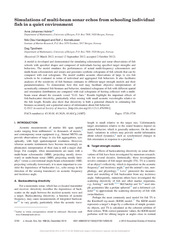Simulations of multi-beam sonar echos from schooling individual fish in a quiet environment
Peer reviewed, Journal article
Published version

View/
Date
2012-12Metadata
Show full item recordCollections
Original version
https://doi.org/10.1121/1.4763981Abstract
A model is developed and demonstrated for simulating echosounder and sonar observations of fish schools with specified shapes and composed of individuals having specified target strengths and behaviors. The model emulates the performances of actual multi-frequency echosounders and multi-beam echosounders and sonars and generates synthetic echograms of fish schools that can be compared with real echograms. The model enables acoustic observations of large in situ fish schools to be evaluated in terms of individual and aggregated fish behaviors. It also facilitates analyses of the sensitivity of fish biomass estimates to different target strength models and their parameterizations. To demonstrate how this tool may facilitate objective interpretations of acoustically estimated fish biomass and behavior, simulated echograms of fish with different spatial and orientation distributions are compared with real echograms of herring collected with a multibeam sonar aboard the research vessel “G.O. Sars.” Results highlight the important effects of fish-backscatter directivity, particularly when sensing with small acoustic wavelengths relative to the fish length. Results also show that directivity is both a potential obstacle to estimating fish biomass accurately and a potential source of information about fish behavior.